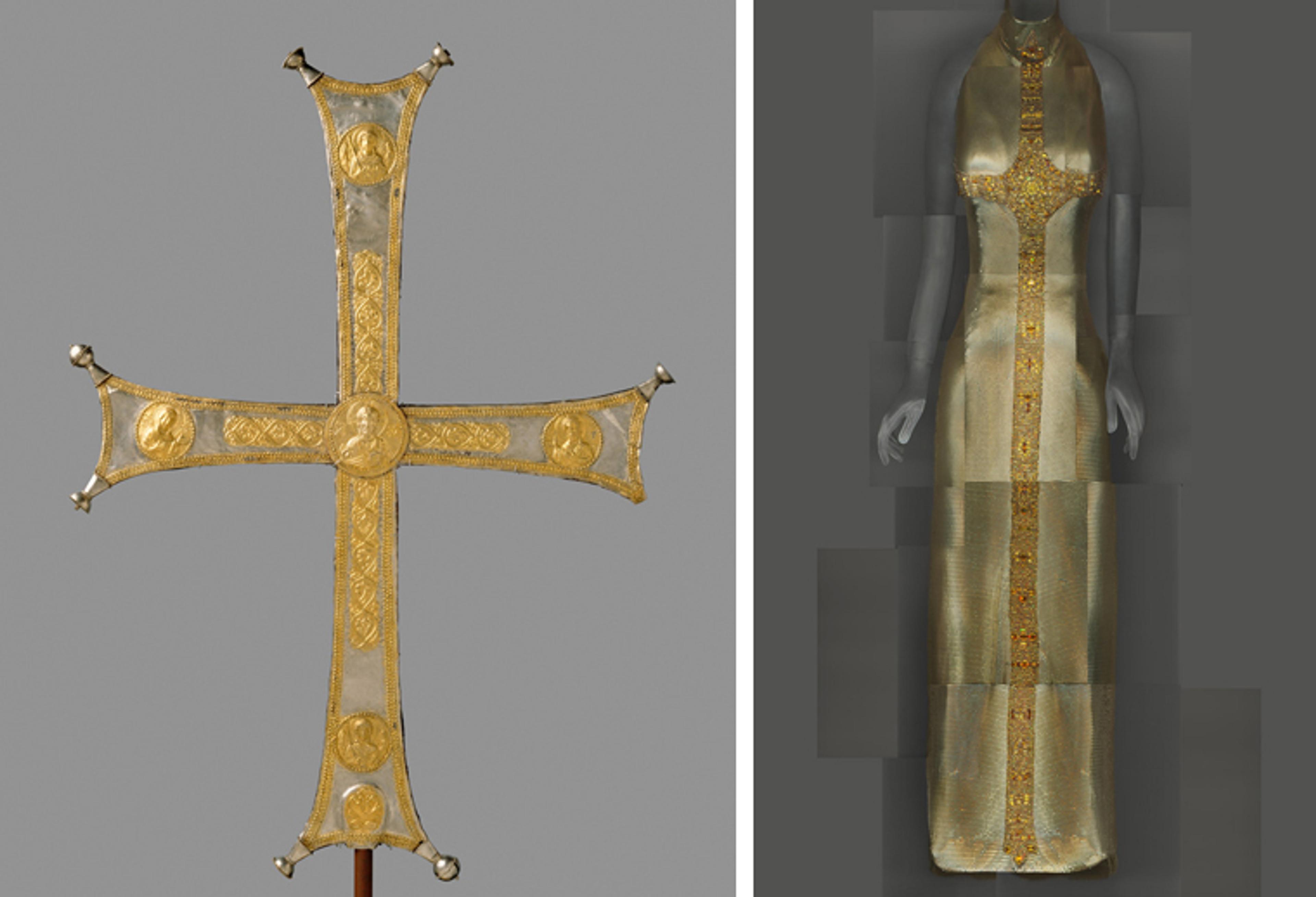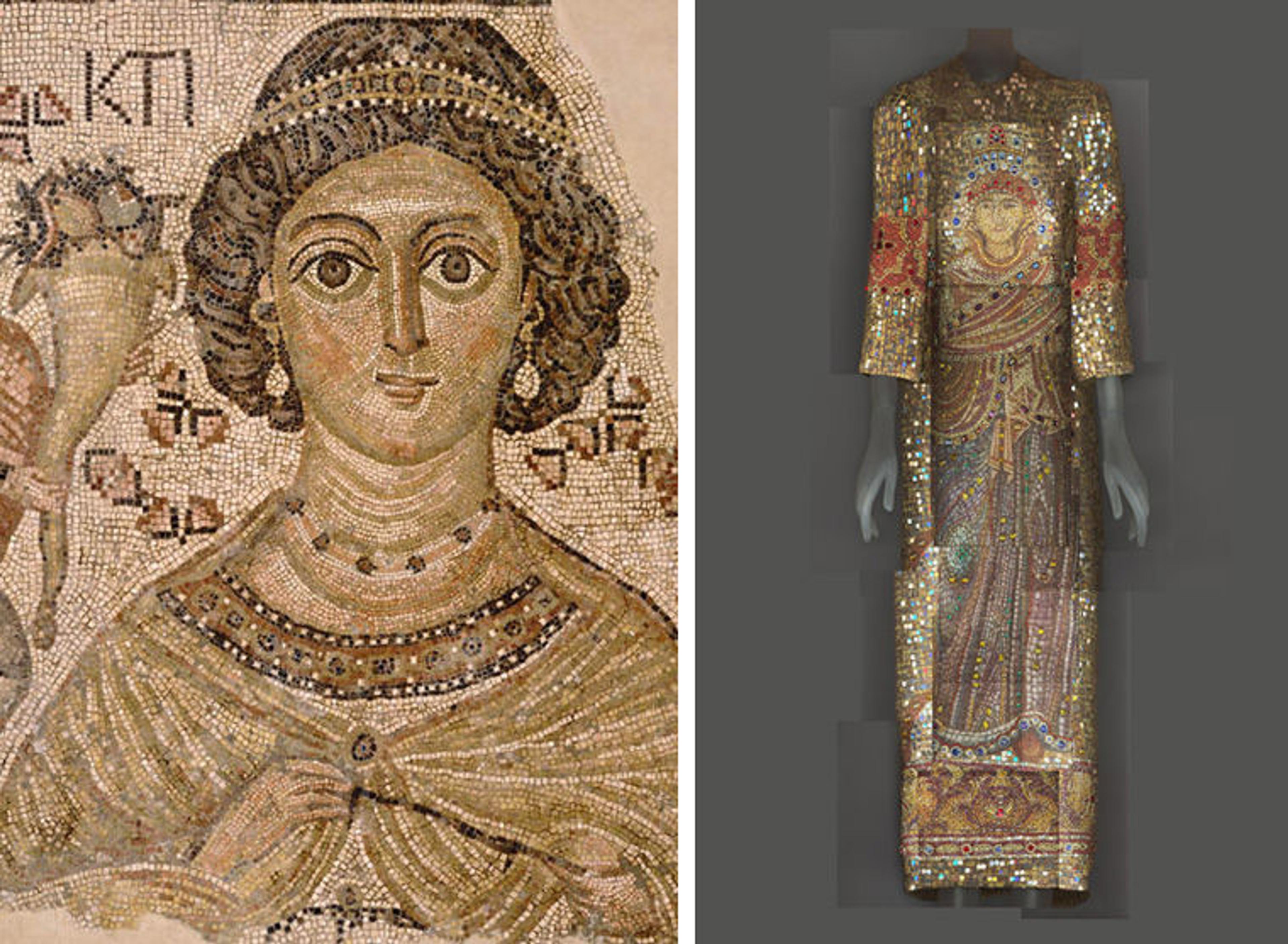The Metaphorical Nature of Creation: Fashion and the Catholic Imagination

Left: Processional cross, ca. 1000–1050. Byzantine. Silver, silver-gilt, overall: 23 7/16 x 16 15/16 x 7/8 in. (59.5 x 43 x 2.2 cm). The Metropolitan Museum of Art, New York, Rogers Fund, 1993 (1993.163). Right: Gianni Versace. Evening dress, autumn/winter 1997–98. The Metropolitan Museum of Art, Gift of Donatella Versace, 1999 (1999.137.1). Digital composite scan by Katerina Jebb
«"The Pope Wears Prada" Newsweek proclaimed in November 2005 in an article describing Benedict XVI's sartorial inclinations. "He may never make the best-dressed lists," the article asserted, "but Pope Benedict XVI is nothing short of a religious-fashion icon, riding in the Pope mobile with red Prada loafers under his cassock and Gucci shades." Within two years, however, the pontiff did make a best-dressed list when, on account of his red shoes, Esquire named him "Accessorizer of the Year" in 2007. In fact, Benedict’s red shoes—made by Adriano Stefanelli, a cobbler from Novara, Italy, who also made versions for John Paul II—belong to a papal tradition that dates back centuries. Their color signifies the blood of Christ's Passion and of Catholic martyrs, as well as the fire of the Holy Spirit at Pentecost, which marks the birth of the church.»
Such proclamations made in today's mass media raise deeper—and even more provocative—contemplations about the role dress plays within the Roman Catholic Church and the role the Roman Catholic Church plays within the fashionable imagination. Such is the basis for the exhibition Heavenly Bodies: Fashion and the Catholic Imagination, opening May 10 at The Met Fifth Avenue and The Met Cloisters. While some practicing Catholics might perceive certain fashions shown as indelicate or even offensive, and other Catholics and non-Catholics alike may be concerned that fashion is an unfitting and unseemly medium by which to convey ideas or reflect imagery related to the sacred and the divine, dress is fundamental to any discussion about religion. Throughout the history of the Catholic Church, dress has affirmed religious allegiances, asserted religious differences, and functioned to distinguish hierarchies as well as gender. Although some might regard fashion as a frivolous pursuit far removed from the sanctity of religion, most of the vestments worn by the secular clergy and religious orders of the Catholic Church actually have their origins in secular dress.

Left: Fragment of a floor mosaic with a personification of Ktisis (detail), 500–550, with modern restoration. Byzantine. Marble and glass, 59 1/2 x 78 5/8 x 1 in. (151.1 x 199.7 x 2.5 cm). The Metropolitan Museum of Art, New York, Harris Brisbane Dick Fund and Fletcher Fund, 1998; Purchase, Lila Acheson Wallace Gift, Dodge Fund, and Rogers Fund, 1999 (1998.69; 1999.99). Right: Domenico Dolce and Stefano Gabbana for Dolce & Gabbana. Ensemble, autumn/winter 2013–14. Courtesy of Dolce & Gabbana. Digital composite scan by Katerina Jebb
The majority of the designers featured in Heavenly Bodies were raised in the Roman Catholic tradition. While many of them no longer practice Catholicism and their relationships to it vary considerably, most acknowledge its significant influence over their imaginations. On the surface, this influence is apparent in their use of explicit Christian symbolism such as the cross and the crown of thorns, but on a deeper level, it expresses itself through the designers' reliance on narrative or storytelling, and specifically on the trope of metaphor, which, as argued by sociologist Father Andrew Greeley, lies at the core of this sensibility. In his book The Catholic Imagination, Greeley states: "The Catholic imagination in all its many manifestations . . . tends to emphasize the metaphorical nature of creation. . . . Everything in creation, from the exploding cosmos to the whirling, dancing, and utterly mysterious quantum particles, discloses something about God and, in so doing, brings God among us."
Greeley's observations about the nature of Roman Catholicism reverberate throughout the exhibition's themes, which will explore how the Catholic imagination has shaped the creativity of designers and how it is conveyed through their fashions. Forged and fueled by stories and images, the Catholic imagination operates on a narrative level, which is where its power lies and its resonance is felt. Heavenly Bodies will express these narratives through a succession of conversations between medieval religious artworks and fashions of the twentieth and twenty-first centuries. Imbued with profound religious meanings, these works in wood, stone, gold, ivory, and enamel will resonate with their fashionable counterparts in silk, lace, satin, organza, and brocade through their metaphorical underpinnings, establishing an elemental principle of consonance.

Left: Reliquary cross, 14th century. Italian. Enamel, silver-gilt, coral, glass, rock-crystal, gold leaf, overall (without tang): 16 15/16 x 14 1/2 x 1 1/8 in. (43 x 36.9 x 2.9 cm). The Metropolitan Museum of Art, Gift of J. Pierpoint Morgan, 1917 (17.190.497). Right: Karl Lagerfeld for House of Chanel. Gilet, autumn/winter 2007–8 Métiers d'Art. Courtesy of CHANEL. Digital composite scan by Katerina Jebb
The Catholic imagination does not operate solely on the narrative level but also on the experiential level—an essential element in the exhibition's configuration, which is intended to evoke the concept and practice of pilgrimage. If a visitor's journey begins at The Met Fifth Avenue in the Anna Wintour Costume Center, they will see pontifical vestments and accessories from the sacristy of the Sistine Chapel, Apostolic Palace, Vatican City. It could then continue in the Mary and Michael Jaharis Galleries of Byzantine Art, with fashions inspired by the religious art and architecture of Byzantium, before advancing into the Medieval Europe Gallery, Medieval Sculpture Hall, and Medieval Treasury. There, garments will reference the hierarchies and gendered distinctions of the Roman Catholic Church, as well as the cult of the Virgin Mary, reflected in the remarkable sculptures and altarpieces on display. In the Robert Lehman Wing, fashions inspired by the cults of saints and angels will be juxtaposed with celestial figures represented in the Robert Lehman Collection, most notably in its exceptional fifteenth-century Sienese paintings. The pilgrimage could then conclude at The Met Cloisters, in northern Manhattan, with garments that relate especially to the reflective worlds of religious orders presented in thematic galleries filled with more than two thousand religious works of art from the ninth to the fifteenth centuries. Or they could experience the exhibition in reverse order; the course of the pilgrimage is theirs to choose.
While the fashions that comprise this journey might seem fanciful, they should not be dismissed lightly, for they not only embody the imaginative tradition of Catholicism but also exemplify its propensities for storytelling. As expressions of the Catholic imagination, they sing with distinctly enchanted and enchanting voices.
Join us at The Met Fifth Avenue and The Met Cloisters in the coming months to see firsthand the ways in which fashion and religion have long been intertwined, mutually inspiring and informing one another—a relationship that has produced some of the most inventive and innovative creations in the history of fashion.
This article was adapted from the introduction to the exhibition catalogue, available at MetPublications and The Met Store.
Related Content
Heavenly Bodies: Fashion and the Catholic Imagination is on view at The Met Fifth Avenue and The Met Cloisters from May 10 through October 8, 2018.
View images of select art and fashion objects and select objects from The Vatican Collection featured in the exhibition.
Purchase a copy of the Heavenly Bodies exhibition catalogue in The Met Store.
Watch a video preview of the exhibition:
Andrew Bolton
Andrew Bolton is the Wendy Yu Curator in Charge of The Costume Institute.